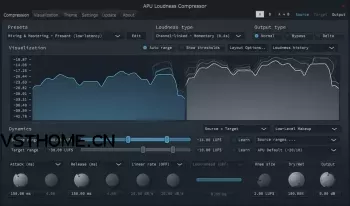TCD | 01.2024 | 14 MB
英文简介:
The APU Loudness Compressor is a compressor/expander designed to support modern loudness types (LUFS, True Peak). This means the compression curve is a function of LUFS measurements instead of RMS or Peak. Since LUFS is a more accurate measure of loudness, the result is very transparent compression, making it particularly well suited for mastering and post-production workflows. The compressor is also capable of operating in a more traditional way, using RMS and Peak units of measurement, so you can have your cake and eat it too.
By default, the compressor operates using a “source range” and “target range” in place of threshold + ratio controls. You can also enable the traditional threshold + ratio controls if you prefer. A drop-down menu located at the top-right of the compressor’s dynamics section allows switching between these modes of operation and others, such as expander, limiter, etc.
With “learn” mode enabled, the compressor will automatically adjust the source or target range to match the source material. This can be a great way to get started with the compressor and can be used as a starting point for further fine-tuning.
Check it out to see if it fits into your workflow. If you have any questions or feedback, don’t hesitate to reach out using the “Contact the Developer” beacon on this website.
Loudness flavors
One of the key features of this compressor is its support for a variety of loudness types. The compressor’s detection circuitry can be configured to use either LUFS or traditional measurement units (RMS, Peak). You can also choose to split or link channels, which is particularly useful for multi-channel audio formats such as Dolby Atmos?.
The compressor’s detection circuitry can be configured to use any of the following loudness types:
Momentary
Momentary is a short duration LUFS measurement (400ms), which is useful for processing the audio’s moment-by-moment dynamics. This mode is responsive but also transparent, making it an appropriate default for the compressor. K-weighting and channel weighting are applied to the compressor’s detection circuitry, improving perceptual accuracy.
Momentary LUFS
Short-Term is a longer duration LUFS measurement (3 seconds), which is useful for processing the audio’s large scale dynamics. Given the longer duration, this mode is less responsive than momentary, but it can be useful for adjusting the bigger picture of the audio’s dynamics. K-weighting and channel weighting are applied as with momentary.
Short-Term LUFS
RMS loudness types use a rolling time interval of 300ms. RMS is a traditional loudness measurement, which is a good first-order approximation of perceived loudness. This mode doesn’t apply K-weighting or channel weighting to the compressor’s detection circuitry, giving it a more traditional character.
RMS
True Peak loudness types are similar to traditional peak measurements, but they are more accurate as they take into consideration inter-sample peaks. These measurements use a time interval equal to the configured block size (1ms by default). This mode is extremely responsive, making it suitable for very fast attack and release times.
True Peak
Peak loudness types are a standard peak circuit, operating on a time interval equal to the configured block size (1ms by default). This is another traditional compressor style measurement. Technically, this mode is even slightly more responsive than True Peak, but it is less accurate as it doesn’t take into consideration inter-sample peaks.
Version 2.1.0
Introducing adaptive window sizes for LUFS/RMS measurements
x64: SAL, VST3, AAX | x86: SAL, VST3
官网: https://apu.software/compressor/







评论0